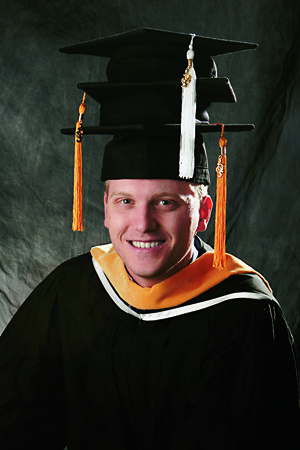By Lisa Ann Jackson and Courtney Dougall
Milt Jones was calming his restless child one night early in 1995 when he saw a story on Nightline about the yet unsolved case of the Unabomber. A graduate student in English at BYU at the time, Jones was well trained to analyze texts, and as the report continued, it all seemed transparent to him: literary analysis techniques might reveal the man and the motive behind the bombs.
What ensued was a game of intrigue and detective work as Jones found himself caught up in the whirlwind of his ideas and theories about the case, leading him to regular contact with the FBI, a master’s thesis based on the Unabomber’s manifesto, and a startlingly accurate profile of the postal terrorist.
“I’m not into mystery novels or law enforcement or anything like that,” says Jones, who now teaches English at Utah Valley State College. “But for some reason I was really hooked.”
After seeing the Nightline report, Jones did some background research into the case and discovered that a BYU professor of electrical and computer engineering, LeRoy Wood Bearnson, was the return addressee on a bomb sent by the Unabomber in the early 1980s. When Jones approached him in 1995, Bearnson still had part in the investigation and helped Jones make his first contact with the FBI.
It took some effort on Jones’ part, but he eventually caught the attention of an agent in Salt Lake City and began a year-long correspondence detailing his theories.
Jones surmised that this terrorist was using a typical literary technique called juxtaposition in which two contrasting elements are set side-by-side. In this case the juxtaposition was a theme common to American literature, that of nature in conflict with technology.
“When the bomb goes off, it is dispensing a symbolic message: technology destroys both nature and itself,” Jones wrote in his first letter to the FBI on Jan. 18, 1995, more than a year before now-convicted Unabomber Theodore Kaczynski was arrested. In his letter, Jones also linked juxtaposition to the victims, noting that victims’ professions usually related to technology and that their names or addresses usually related to nature, like the BYU professor whose middle name is Wood and whose profession is computer engineering.
For Jones, a letter claiming responsibility for the bombings printed in the New York Times on April 26, 1995, confirmed his notion. The letter read, “Through our bombings we hope to . . . propagate anti-industrial ideas and give encouragement to those who hate the industrial system.” It also stated that victims were targeted because of their professional connections to technology.
Jones’ interest in the case piqued, and he picked up another literary trail when he shared his ideas with Dallin D. Oaks, BYU associate professor of English. To Oaks, these anarchist bombings resounded of Joseph Conrad’s novel, The Secret Agent, in which the main character is a university professor turned anarchist. The book details the professor’s thought patterns, hermit-like habits, and bomb making. From this, Jones surmised that the Unabomber was familiar with this Conrad novel and possibly others–all information he passed on to the FBI in 1995.
Jones and Oaks decided Jones should combine literary and linguistic analysis techniques to develop a profile of the Unabomber based on the manifesto printed in theWashington Post on Sept. 19, 1995. This analysis became Jones’ master’s thesis and concluded that the manifesto “reveals a mind working in isolation, without benefit of either a good sounding board or insightful editor” and that its author lived a “lonely, suffering, nonconformist life.” Jones also tagged the bomber as an extremely intelligent and educated individual, perhaps with a strong background in math.
The case began to unravel on April 11, 1996, when Kaczynski was arrested, four months after Jones turned in his thesis and graduated from BYU. At the time of the arrest, Kaczynski had lived alone in a remote Montana cabin for 25 years after leaving his post at the University of California, Berkeley, where he was a math professor.
On July 9, 1996, a story in the Washington Post detailed FBI suspicions that the Unabomber had been influenced by Conrad’s novel, The Secret Agent. The article revealed that the FBI had worked with Conrad scholars before the arrest to glean profile details this novel might lend. As it turned out, Kaczynski had long been a Conrad fan, having read his complete works about a dozen times and even having used “Conrad” as an alias on occasion.
There is little chance Jones or anyone else will know for sure if his analysis would have led the FBI to Kaczynski’s doorstep. In the end it was Kaczynski’s brother who got authorities to Montana. But with the capture and conviction of the Unabomber, Jones at least knows that much of his analysis was right on, and he is confident that the profile information–particularly the Conrad connection, which he hasn’t been able to trace back to any other source–was helpful for the FBI when they did finally arrest a suspect.
And the next time someone gives Jones that quizzical look familiar to English students and asks, “What does one do with a master’s in English?” he can answer without missing a beat, “Fight crime, of course.”









